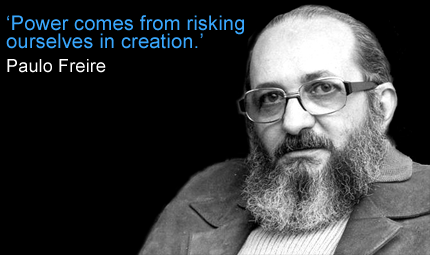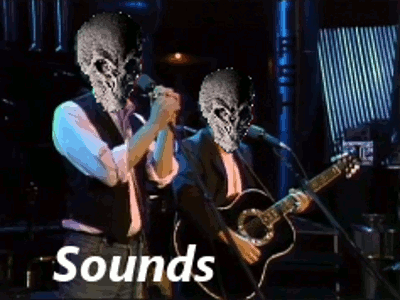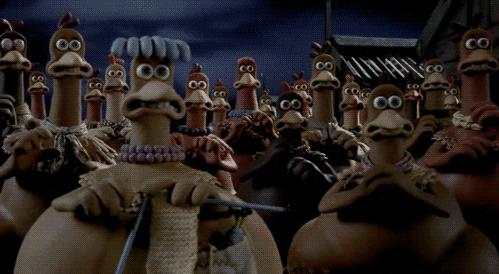PROLOGUE
In October of 2015 a cohort of 40 or so people gathered in Squires for InterCom training. During the training one scenario required a person to use a slur word of some kind during the circle to give the facilitators the opportunity to navigate ways of responding to unexpected events in the process of a facilitation.
But, there was a small hiccup. One of the participants, let’s call him J, who wasn’t a facilitator was out of the room when we disclosed who was going to be using a slur word and why. As such, he, a tall black man (these are important demographics to note), didn’t know going into the circle that another person, a white man, had been asked by the trainers to use the n-word during the circle.
The facilitators were brought back in, given their topic, and things started smoothly enough. Then, in the midst of the conversation, the white man used the n-word and a discussion quickly emerged about that word, its use, and reclamation. J reacted strongly to the use of the term and at one point said “Look, if you use that term again I’m going to have to do something”.
How would you interpret this phrase? How do you think people in the room interpreted J’s response?
INTRODUCTION
While this week’s readings were concerned with adjusting, and mitigating, the impact of implicit bias, utilizing “brave” space as opposed to “safe” space discourses, and what I took to be, in one respect, an appeal to long term tangible increases in profit that can accrue when a workspace and place is diverse, I want to take us in a different direction and talk about some things the readings didn’t discuss all that explicitly. While I will come back to elements of bias, especially given the title of this post, I want to start a bit differently than I normally do.
Rather than start with a long, rather drawn out explanation of the concepts at play, here are some scenarios to ponder.
SCENARIOS
Scenario 1:
Think back to the first day of class. If you’re teaching or a TA, or have been in the past, think back to how you take roll on day one (assuming you do so). If you’re not teaching or a TA, think back to when you were a student and how your teachers/professors took roll.
Question: How do we usually take roll in a class? Are there any unnamed impacts of certain methods for taking roll/learning names in a class?
Scenario 2:
You are in class and notice two students having a conversation. One student is talking and then the other student interrupts them and says “Look, just tell me when we need to meet. I can meet at 2. When can you meet?”. The first student looks frustrated and starts talking again making the same points they made earlier to the obvious frustration of their peer.
Question: What is going on? How might the parties feel?
Scenario 3:
On a different day in class two students, Alex and Sam, are talking about something before class. Suddenly you notice Alex using a lot of hand motions and get very close to Sam. Sam takes a step back before continuing the conversation.
Question: How would you read this scenario with only the information provided? Would anything change if you knew the gender, or the race, of Alex and/or Sam?
PERSPECTIVES
Scenario 1: Universal Design
When I reflect on my experiences in the classroom, the way roll/attendance tends to get called in classes where the professor cares about knowing names is as follows: on day one the professor goes down the list, calls your first and last name, you say you’re here, and if you have a different name that you go by you tell the professor and they edit the roster.
Sounds normal, right? Many folks I’ve talked with in my department say that this is just the model that they have always used and seen used. But who could be harmed with this model or, sometimes, put in danger?
For trans* students, especially those students who don’t have a name change in the system, and sometimes who can’t get their name changed in the system for a myriad of reasons, the first day of class can be a bit stressful. Some students email their professors, individually, semester after semester to give them a heads up that they go by a name that’s not on the roster (or “obvious”). But, there are a few hiccups here. The first is that the that name information doesn’t always make it way onto the roster that will be called on day one and thus the bootstrapping may have been in vain. The second is that this requires the student to “out” themselves to someone they might not know yet and not everyone responds positively, or even neutrally, to trans* students in the classroom.
As such, I think that when it comes to designing our classrooms, we ought to operate with a mind towards mitigating the harms, and the need for bootstrapping, for our students. This isn’t to say that universal design can fix everything, but certain design moves can help those who need it the most and also those didn’t realize that they stand to benefit from changes to the system.
As such, here is a proposal: when we take roll, rather than call out the first and last names for the students, call out the last name only. If you’re like me, you will still mispronounce it but hey, now we only have to mispronounce the last names! After you call out the last name, have the students respond with whatever they go by. There is no need for the entire “My legal name is William but I go by Bill” hoop jumping, for trans* students if they have a name that they want to go by that’s not their “legal” name no on in the class will be the wiser, and you only have to struggle to pronounce the last names (this time). This is one example of a universal design move in the classroom that benefits more than just trans* students even if they may benefit from it more than some others.
While there is more to say about universal design, to end this section, I want to ask a question:
What are some other examples of universal design that we can use in the classroom and what are our reasons for not shifting to different models?
Scenario 2: High Context and Low Context Communicators
For me, I see this kind of interaction fairly regularly and it speaks to a difference in context communication. By this, I mean that some people are high context communicators (HC) and some people are low context communicators (LC). For folks who are HC communicators, especially in new settings, it is not uncommon for them to need to speak uninterrupted in order to feel heard and valued. If they are interrupted, or rushed by folks who are LC communicators, they may feel dismissed or unheard. In contrast, folks who are LC communicators tend to want to get to the point, can come across as blunt for HC communicators, and may also become very impatient with HC communicators.
In the classroom, or in spaces in general, we need to be aware of how differences in context communication can aid, or hinder, the interactions of folks in those spaces. Folks with different styles of communication, or with different context and cultural traditions, may interpret classroom activities, films, or discussions in different ways and respond to those things in a myriad of ways. If we were to ignore the roll that a difference in context played in those interactions, we risk ostracizing a group of learners if the classroom is set up for a certain kind of context learner to the detriment of the other types of learners in the space.
As with the last scenario, oo end this section, I want to ask a question:
When designing classrooms, how to we create and make space for multiple styles of communicators? How do we address conflicts that arise when there are differences in styles?
Scenario 3: Oral vs Print Culture
Sometimes when students interact, body language, tone of voice, mannerisms, and other indicators can be actual indicators of mood/affect. Other times they can be misinterpreted to indicate moods/affects not currently present. In the above scenario, it is not uncommon for folks to take the actions of Alex as either indicating excitement, anger, or other moods that tend to reflect what we as the observer have tended to associate certain actions with (e.g., hand motions means angry) in our own histories. As such, the purpose of this scenario was to get folks to reflect on how we as educators and facilitators may interpret language, especially bodily language, based on our own preconceptions of what anger, excitement, engagement, and the like look like with our academic training.
For, within academia we operate in what is called a “print” culture (PC). This kind of structure is such that emotions tend to be rather limited, communications for formulaic and dictated by tradition and norms within the academia, boundaries and distance (literal and metaphorical) tends to be emphasized, etc. Sound familiar?
In contrast, “oral” culture (OC) operates in a more emotional and expressive manner. The communications are focused on the relationships among the interlocutors, there isn’t really a formulaic or structured element to the conversation as opposed to flowing narrative, and boundaries and distance (again, literal and metaphorical) tend to be down played. The interlocutors connect with one another via emotions, physical closeness, etc.
When folks from a PC interact with folks from an OC, there can be tensions that we need to name. To the PC folks, the OC folks may come across as hostile or threatening due to their close proximity and use of hand motions when, for the OC folks, how they are acting and interacting is an indication of their engagement with the person and topic at hand. There are other things to name, and we can process though them later.
To end this section, I want to ask another question:
How might someone from an OC find academia? Specifically, how might someone who is a first generation college student, with an OC background, find their peers and professors and how would their perception of the climate effect their success?
EPILOGUE/CLOSING THOUGHTS
When the scenario with J played out in the circle, we processed through not only what was said but also how people interpreted J’s words. For some people, and this was the case for a number of the white folks in the room, J’s words came across as a threat. One person said, “I thought he was going to hurt someone” hence the title of this blog post.
When we asked J what he meant by his words, he said that he had meant he would leave the room. His “doing something” would be removing himself from that space.
When it comes to our classrooms and how we design them there are a few things I think we must all be conscientious of. On one hand there is the design of the space, its accessibility, the removal of needless barriers for students, etc. This can include changing how we do class rolls, for example, or even using only gender neutral/name only references for students when we don’t know their pronouns (a bit more contentious of a UD move).
On the other hand another important element is knowing ourselves. Sometimes, we might misinterpret what a student says, much like J’s colleague very much erred in their reading of his exclamation. In trying to move through those tensions both for ourselves and among the students we work with, we need to know what we’re bring to the table and what they may be bringing to the table.
While we facilitate a classroom, we should know the culture we have, our communication styles, if we are Low Power Distance or High Power Distance (something I didn’t discuss), etc.. We will be bringing our histories and biases into the classroom. Rather than be ashamed to acknowledge our tendencies and biases we can use our knowledge of them to be better facilitators across and among differences in the classroom.
The talking points for this blogpost are taken from and inspired by materials found in the VT InterCom: Dialogues for Social Change program run by Dr.Christian Matheis and the IEC here at Virginia Tech. They can be found, in much more detail, in the Human Relations Facilitation, Modes of Communication, and Responses to Conflict training packet. Additional information can be found in: Intercultural Sensitivity for the Health-Care Professional Eric H.F. Law, M.Div. with Elizabeth Snow, MA, OTR 1995











